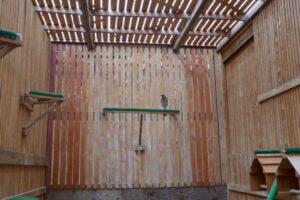Enclosures for Recovery
Following critical care, raptors are moved to an outdoor enclosure unit that is appropriate for their level of rehabilitation.
Hospital Enclosures
Once stable, a raptor may be moved to a hospital enclosure to continue its recovery. While in hospital enclosures birds in our care require restricted activity or medication. This area is also used for large high stress patients including osprey or bald and golden eagles.
Recovery Enclosures
Birds are moved to the recovery enclosures when they are ready for limited activity. These patients are eating on their own, no longer on medications and broken bones or wounds have healed and no longer require intensive medical management. While in recovery enclosures, the raptors will become stronger and build up their muscles in preparation for flight. The perches in these enclosures can be arranged to accommodate individual bird’s injuries and disabilities and can be changed over time as the bird’s skills improve.
Flight Enclosures
Our current facility has 6,000 square feet of flight enclosures to provide a spacious area for flight reconditioning, strength and stamina. Enclosures vary in size ranging from small, for small falcons, accipiters and owls, to large, for hawks, owls and eagles.
Some of the flight enclosures are equipped with sliding doors to allow the flexibility to extend flight areas when necessary. Several birds may be housed together but different species are not often mixed.
While in flight enclosures, live prey are introduced into the cages and the birds’ hunting skills are evaluated. It is critical to evaluate birds recovering from leg injuries, head trauma or other neurological issues such as West Nile virus. Immature birds also gain important practice before having to hunt for themselves in the wild.
Birds in the flight enclosures are observed and their progress is monitored regularly.
The Stages of Rehabilitation
Would you like to help the recovery of an injured raptor? Click here to Donate.

